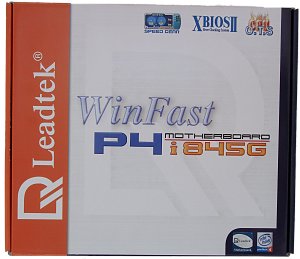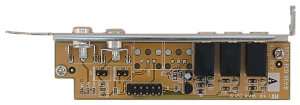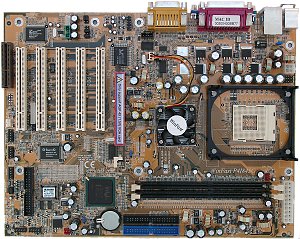Leadtek P4I845G (i845G) Mainboard
|

Mainboards from Leadtek do not look exotic anymore because the company
was earlier mostly known as a video card maker. The model we test today
doesn't shine with its package but its quality and functions are not just
ordinary.
Accessories:
- Package of a standard design;
- Documentation: user manual in English;
- Cables: 1 ATA66/100/133 and FDD;
- Bracket with Front, Rear, Center/Sub controllers and an SPDIF-In/Out Coaxial
one;

- Bracket for the rear computer panel;
- CD containing:
- drivers;
- Adobe Acrobat Reader;
- Leadtek Speed Gear;
- Award Winflash;
- DirectX 8.1.

The layout is far not striking, but several quite frequent downsides
are not fatal: audio-ins are in front of the PCI slots, the FDD is behind
them and when a video card is installed it's difficult to handle the IDE
modules. Also, it can be difficult to reach some jumpers when the board
is already installed. Their functions are shown on the textolite.
The 3-channel switching voltage regulator incorporates 12 capacitors
of 2200 uF.
The following controllers are integrated:
-
audio controller based on the C-Media CMI8738/PCI-6ch-MX chip supporting
5.1 audio systems and having a connector for front audio-outs and an SPDIF
one;
-
network controller based on the Realtek RTL8100B chip supporting 10BaseT/100BaseTX.
Thanks to the Winbond W83637HF-AW SmartIO controller the board supports
readers of smart cards and SD and MS cards (and has connectors) for them.
The system monitoring is supported by the Winbond W83637HF-AW chip.
What is controlled:
-
voltage of processor, AGP bus, +3.3, +5 and +/-12 V, VBAT and +5 V Standby;
-
speed of 3 fans;
-
temperatures of the processor (a built-in sensor), and the board (a built-in
sensor).
There are 2 connectors for adjustable and 1 for unadjustable connection
of fans.
Brief characteristics of the board: memory slots - 2 DDR SDRAM;
expansion slots - AGP/ 5 PCI /CNR; I/O ports - 2 COM/ LPT/ 2 PS/2/ 6 USB
2.0; dimensions - 305x235 mm.

Adjustment can be carried out with:
| jumpers and switches |
Jumper to clear up the CMOS |
|
| Jumpers to choose a FSB frequency |
Auto, 133 MHz |
| Jumpers for setting processor's voltage |
1.1-1.85 V in 0.025V steps |
| Jumper for choosing a mode of the Bass/Center channel |
Normal/Inverse |
| Jumper for choosing a connector for the 6th USB port |
CNR/Onboard |
| Jumpers for setting audio-outs' mode |
Back Panel/ Front Panel |
| BIOS based on the 6.00PG version from Award |
Setup of memory timings |
+ |
CAS Latency, Active To Precharge Delay, RAS to CAS Delay, RAS
Precharge, Turbo Mode |
| Setup of memory frequency |
+ |
Auto, DDR200, DDR266, DDR333 |
| Setup of AGP bus |
- |
|
| Setup of PCI bus |
- |
|
| Changeable scaler of AGP and PCI buses |
- |
|
| Manual assignment of interrupts |
- |
|
| Changeable FSB frequency |
+ |
100-250 MHz in 1MHz steps |
| Changeable CPU multiplier |
+ |
x8-x50 |
| Changeable core voltage |
+ |
1.1-2.0 V in 0.025V steps |
| Changeable memory voltage |
+ |
+0.1 V, +0.2 V |
| Changeable chipset voltage |
- |
|
| Changeable AGP bus voltage |
+ |
+0.1 V, +0.2 V, +0.3 V |
We used the latest available version of the BIOS of 09/07/2002.
Despite decent overclocking tools this board seems to be matching not
an overclocker's system but a peaceful home computer which usually makes
use of an audio adapter, a flash card reader etc.
Test results:
|
|




